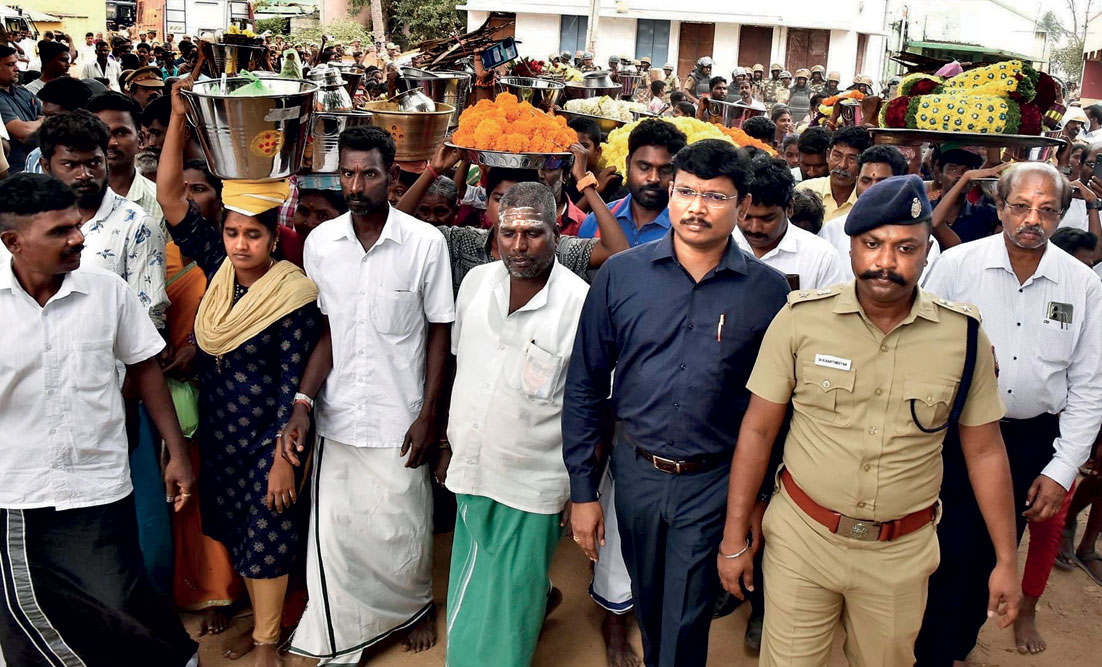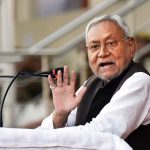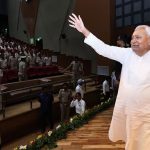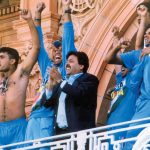The First Rebels
When Madras was at the forefront of the struggle for Dalit emancipation
/wp-content/uploads/2023/08/Firstrebel1.jpg)
(Clockwise from left bottom) Rettaimalai Srinivasan, MC Rajah and Iyothee Thass (Illustration: Saurabh Singh)
ON AUGUST 2, OVER 200 Dalits from Chellankuppam village in Tamil Nadu’s Tiruvannamalai district entered the local Mariamman temple, administered by the state’s Hindu Religious and Charitable Endowments Department, for the first time in decades. Although the Tamil Nadu Temple Entry Authorisation Act of 1947 allows Hindus of all castes to enter temples, it still takes the occasional act of resistance for Dalits to claim right of access to public spaces. Even in a state governed by politicians who trace their ‘Dravidian’ ideological lineage back to the movement for social justice, self-respect and rationalism led by EV Ramasamy, aka Periyar, Dalits have to work hard to ensure that their rights don’t just remain “pious pronouncements”, as BR Ambedkar put it. In the year 1925, Periyar, along with Congress leaders, famously led an agitation in the neighbouring Travancore state demanding access to the Vaikom temple for all castes. But it was in Madras Presidency that the rebellion against caste first took shape, with a generation of middle-class subaltern leaders asserting themselves as early as the mid-19th century. Researcher J Balasubramaniam, who is an assistant professor at Madurai Kamaraj University, has shown that Dalits brought out 42 Tamil journals between 1850 and 1947. One of them was Tamilan, first published as Oru Paisa Tamilan— the name perhaps a lament for the low worth accorded to the depressed classes—in 1907, by Iyothee Thass, born Kathavarayan in 1845. A practitioner of Siddha medicine, Thass sought to give the outcastes of Madras an aboriginal identity and thereby, help them reclaim their pride. He attempted to intervene in the census process in 1881 on behalf of his people, asking that they be recorded as the “original Tamils”. To him, caste names like ‘Paraiyar’ were disparaging and he sought to free Dalit identity from discourse that denigrated them as people sans a history other than that of the manual toil and the oppression they were subjected to.
According to Gajendran Ayyathurai, an anthropologist and historian who teaches at the Centre for Modern Indian Studies, Göttingen University, Germany, the “Tamilan could be compared with The Chicago Defender in America, in terms of its timeframe, design, radical anti-race contents, health columns, local and international news, and reach among the marginalized that is, African Americans.” Ayyathurai adds, “Like the Tamilan, which rejected the caste names of communities such as Paraiyar, The Defender—founded on May 5, 1905 by Robert S. Abbott—never used the categories ‘negro’ or ‘blacks’. Instead it preferred usages such as ‘the Race’— the Race men, and the Race women— to refer to the African Americans.” He contends that Thass, once a believer in Advaita philosophy, had an emotional epiphany at a meeting of the Madras Mahajana Sabha, in which he took part as a representative of the Nilgiri area, in April 1892. “Thass’ assumptions about Hindu identity, that Saivism and Vaishnavism are common heritage of all Indians and hopes about common brotherhood among Indians, came to a rude collapse,” Ayyathurai writes. In a piece titled ‘To the casteless poor’ published in Tamilan on October 21, 1908, Thass recounted his experience from 16 years ago—about how Dalit issues were struck off the agenda by caste Hindu representatives at the meeting, and about his own intervention at the meeting: “Sir, it is said that for all kinds of people in the world the gods and temples are common. If that is the case, then, why should not those who are Vaishnavites and Saivites from among these communities, i.e., those oppressed as lower castes/untouchables, be allowed to enter the Vishnu and Siva temples, since this will not only foster mutual understanding and well-being among each other but also strengthen the concerned religions.” This early demand for temple entry was met with loud and vehement disapproval, and even admonishment by an upper-caste representative. Disillusioned, Thass founded a Tamil Buddhist movement and attempted to recast Dalits as descendants of Buddha’s clan, the Sakyas. He had already declared, way back in 1886, that the socalled untouchables were not Hindus.
Thass juggled his ethno-spiritualism with his role as a leading member of the Dravida Mahajana Sabha, appealing to the institutional modernity of colonialism to set up schools to educate Dalits, to grant them access to public spaces, and to take action against casteist practices in the villages. Petitions he filed with the British government led to better everyday living outcomes for fin-de-siècle Dalit society. A member of the Paraiyar elite that had emerged under British rule—finding employment as house staff, hospital and mine workers, soldiers and so on—Thass, like other Dalit intellectuals of the time, was disconcerted by the increasing brahminisation of colonial society. With the publication in 1858 of a Protestant Scottish missionary Robert Caldwell’s philological work, A Comparative Grammar of the Dravidian or South Indian Family of Languages, some Tamil scholars had begun to probe their ancient civilisational past and question the Brahminical Hinduism of the northern race. Thass and reformist leaders like Periyar after him, who rooted their anti-caste epistemology in a narrative of Dravidian civilisational history, continue to shape modern ideas of Tamil identity and politics.
Reformist leaders like Iyothee Thass and Periyar, who rooted their anti-caste epistemology in a narrative of Dravidian civilisational history, continue to shape modern ideas of Tamil identity and politics
The Adi-Dravida emergence, scholar Anbu Ponnoviyam has argued, proved foundational to the Dravidian movement, even if the latter hasn’t readily acknowledged this beyond issuing stamps and announcing a memorial. The similarities in the ideas of the two are evident from the writings of Dalit intellectuals like Thass, whose journal issues were collected and published by Ponnoviyam. Other journals from a time when the air of Madras crackled with the possibility of uplift and emancipation have vanished without a trace. A single page of Rettaimalai Srinivasan’s weekly, Paraiyan, has survived. The only Paraiyar among 400 students at a residential school in Coimbatore, Srinivasan worked as an accountant in Ooty and established the Paraiyar Mahajana Sabha in 1891—it later morphed into the Adi-Dravida Mahajana Sabha, which continues to be a district-level body working across Tamil Nadu—and published Paraiyan from 1893 till 1900, when he left for South Africa. Known for accompanying BR Ambedkar to the first two Round Table Conferences in London in 1930 and 1931—although he seems to have said little, leaving Ambedkar to do the heavy lifting—Srinivasan authored what may well be the first Dalit autobiography, published in 1938. Thass was his brother-in-law, but the two had a healthy rivalry going between them and their respective outfits. For Srinivasan, Paraiyan was an assertion of identity. “Unless a member of the Pariah caste comes forward and says ‘I am a Paraiyan’, he will not be able to celebrate freedom and will remain oppressed and a pauper. Therefore, I published a journal crowned with the name ‘Paraiyan’. It was published in October 1893. It was a small monthly with four pages. It cost 2 annas a copy. People of my caste, the ones called ‘Paraiyar’, endorsed it with great enthusiasm. The advertisements for the journal and the first print run cost Rs. 10. In two days, some 400 copies were sold inside Chennai city. In three months, the journal became a weekly, and after two years, there was a printing press,” he wrote in his memoir. Thass detested the very name of Srinivasan’s journal, and Srinivasan opposed the idea of finding salvation through conversion to Buddhism, even issuing a statement asking Ambedkar to reconsider his decision to convert. Both, however, believed in the same cause, which was to establish an Adi-Dravida identity.
Srinivasan was among the first mass leaders with the capacity to mobilise thousands of Dalits for conferences and for signing petitions. He demanded that the government set up special schools for SC students and vehemently opposed the nationalist project of conducting civil service examinations in India. “While it is considered 330,000,000 of Indians are kept under subjection by the British, it should equally be considered that onefifth (66,000,000) of that population is kept under perpetual oppression by the other four-fifths,” he wrote in an open letter to Gandhi. After 1918, when Dalits were first included in legislative bodies as representatives of their communities, leaders like Srinivasan, MC Rajah, R Veeraian and LC Gurusami began to use legislative politics to fight for access, land rights and equal status. They became vocal members of the Madras Council, petitioning it repeatedly to recognise access to public spaces as a universal right. “Their participation in formal governmental arenas had an important consequence that continues to shape political modernity in India. These activists sought protections for what they understood as rights guaranteed to them by virtue of their citizenship alone,” writes Rupa Viswanath in The Pariah Problem: Caste, Religion, and the Social in Modern India. “Numbers of submissions by Depressed Classes representatives to the Madras Legislative Council in the years between roughly 1920 and 1925 far outweigh queries submitted by other constituencies. The most active in this regard, R. Veeraian, for example, alone submitted over a hundred letters or queries to the government in the twoyear period between 1924 and 1926,” she notes.

When Rajah and Srinivasan brought to the attention of the Royal Commission on Superior Civil Services that in most courts in the Presidency SC litigants were forced to remain outside, providing evidence through peons as they stood before doorways or windows, Indian and British officials alike were highly sceptical of these charges, Viswanath writes. But rule of law already permitted one and all to enter the civil courts, and the diffidence of the lower castes was not the business of government. Representatives like Srinivasan, Veeraian and Rajah made it theirs. In 1925, Veeraian objected to the use of the term ‘Paraiyan’ before the names of Adi-Dravidas in the court summons at Ambur, North Arcot district, writes Balasubramaniam. “As a result, they went for a new identity that gave respect,” he adds. It was Rajah who introduced a bill in the Madras Legislative Council on March 15, 1922, which awarded the name ‘Adi-Dravida’ to any Hindu belonging to any of the Paraiyar, Pallar, Valluvar, Mala, Madiga, Chakkiliyar, Tottiyar, Cheruman and Holeya communities. A century later, the Viduthalai Chiruthaigal Katchi (VCK), a party that represents the interests of Dalits in Tamil Nadu—it won four of the six Assembly seats it was allotted by the Dravida Munnetra Kazhagam-led alliance in 2021—wants to consolidate nearly 60 sub-castes of Dalits in the state under the umbrella of a common ‘Adi- Dravidar’ identity to “annihilate caste among the scheduled communities”. Although the term initially referred to Paraiyars alone, it has been loosely used to identify Scheduled Castes in general. The state’s SC ST welfare department is in fact named the Adi Dravidar and Tribal Welfare Department.
“As the first Dalit leader to be nominated to the Council, Rajah took the political modernist approach to fighting for civil rights. He was a mass leader whose meetings were attended by thousands. Though aligned with the Justice Party, he pulled them up when they took an anti-Dalit approach,” says D Ravikumar, VCK MP from Villupuram and a senior party leader.
Rajah had emerged as a national Dalit leader before Ambedkar. He was elected president of the All India Depressed Classes Association at a meeting in Uttar Pradesh in 1922, Balasubramaniam says. “The following year, Ambedkar was invited but he didn’t turn up. Rajah was elected president again and Ambedkar was selected as vice president but some people took issue with the fact that he couldn’t be physically present. This kind of rivalry between the two leaders that began in the 1920s ended with Rajah being sidelined eventually,” he adds. The pact Rajah signed with Hindu Mahasabha leader BS Moonje in 1932 was a precursor to the Poona Pact signed by Ambedkar and Gandhi later that year. The Rajah-Moonje Pact was the first ever agreement between caste Hindus and the depressed classes on reservations and a joint electorate, even if soon superseded by Ambedkar’s pact.
MC Rajah was a prominent leader of the Dalits and a precursor to Ambedkar. The pact Rajah signed with Hindu Mahasabha leader BS Moonje in 1932 was the first agreement between caste Hindus and the depressed classes on reservations and a joint electorate
It wasn’t just Rajah who was left out of the pages of history. Srinivasan and Thass had all but disappeared from public memory until their writings were republished in the 1990s, foregrounded by an emerging Dalit consciousness. “It is ironic that Ambedkar’s birth centenary celebrations helped shine the spotlight on these forgotten icons from Tamil Nadu,” says Dalit scholar Stalin Rajangam. “A lot of new material about them came to be unearthed in the following years, based on which Tamil Dalit writers are finally beginning to reinterpret history. For instance, Azhagiya Periyavan relied on Iyothee Thass’ journals for his 2017 novel Vallisai, where he writes about a Dalit movement. Thass is a character in Jeyamohan’s 2014 novel Vellai Yaanai. You will find Thass and Srinivasan’s photographs scattered throughout filmmaker Pa. Ranjith’s oeuvre—in Madras (2014), Kaala (2018) and Sarpatta Parambarai (2021),” Rajangam says. The first state to rebel against caste is finally honouring historical actors who fought for essential freedoms.
About The Author
MOst Popular
3

/wp-content/uploads/2025/07/Cover_Crashcause.jpg)














More Columns
Bihar: On the Road to Progress Open Avenues
The Bihar Model: Balancing Governance, Growth and Inclusion Open Avenues
Caution: Contents May Be Delicious V Shoba